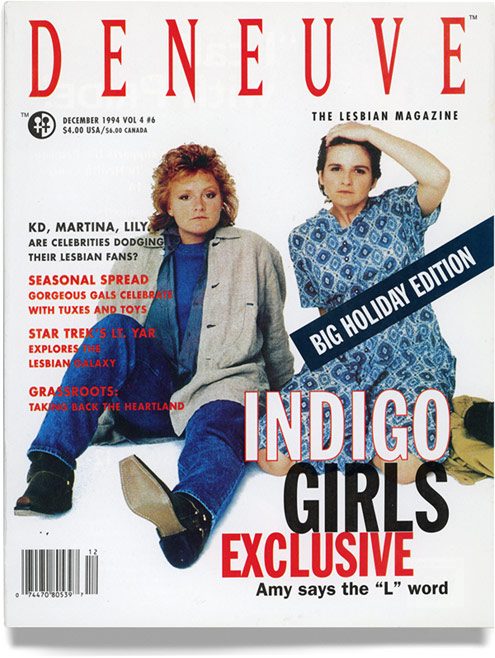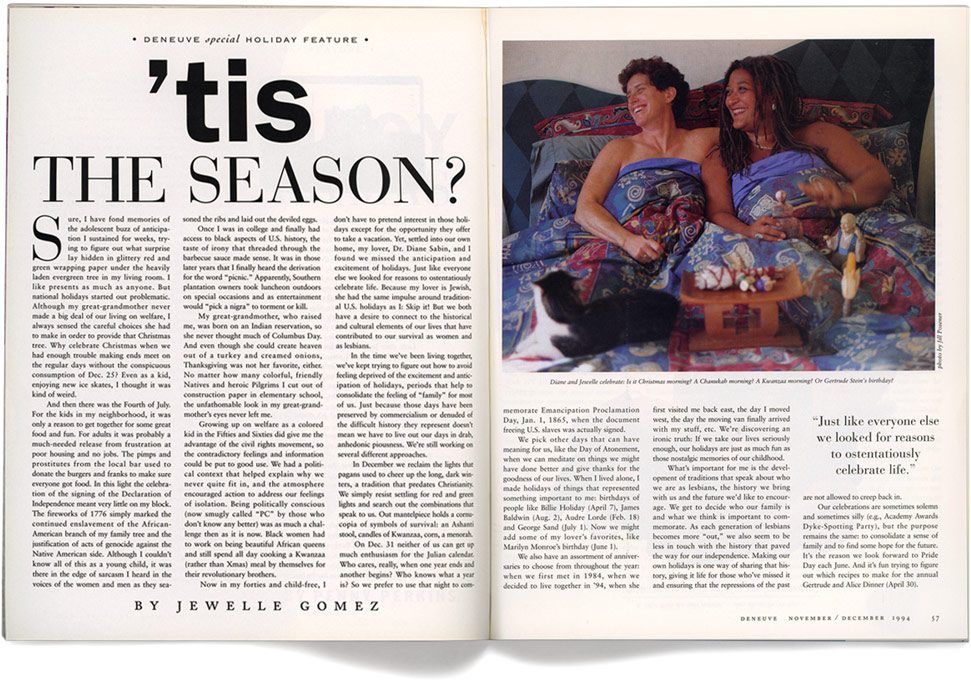The women who gravitated towards Curve were often so unique and multitalented that it was entirely possible a lesbian might be both the subject of one article — and the author of another! Jewelle Gomez is one such lesbian.

The women who gravitated towards Curve were often so unique and multitalented that it was entirely possible a lesbian might be both the subject of one article — and the author of another! Jewelle Gomez is one such lesbian.
“The Crown Jewelle” by veteran lesbian political columnist Victoria Brownworth appeared in the April 1994 issue of Deneuve and introduced readers to Jewelle who was making a splash then with her acclaimed Black lesbian vampire novel, The Gilda Stories — winner of two Lambda Literary Awards.
Jewelle was a San Francisco transplant. She left her New York City literary career behind to move to the Bay Area in 1993. The article reveals her struggle to establish herself as the prolific, published author she is today; her journey as a Black, out lesbian; her friendship with Audre Lorde; and her interracial, interfaith relationship. It’s the kind of substantive cultural profile that Curve became known for.
“Everything I do is related to my being Black, my being a lesbian,” Jewelle said in the article. “I need community in order to write.” Not even a year after touching down in her new home, Jewelle found another home in the magazine, and even shared details of her domestic bliss by penning a Special Holiday Feature in November 1994 issue titled “’Tis the Season?”
The spread boasts a gorgeous color photo of Jewelle in bed with her partner (now wife) Dr. Diane Sabin, captured by Jill Posener. In the article, Jewelle ponders the meaning of national holidays such as Fourth of July, “Columbus Day”, Thanksgiving, and Christmas as a Black lesbian whose great-grandmother “was born on an Indian reservation.”
Jewelle’s article is at once an insightful history lesson, cultural critique and political manifesto shared through her own deeply personal intersectional lens. She describes how in December she and Diane mix various customs: pagan, Christian, African, Jewish, and how instead of New Year’s Eve they celebrate Emancipation Proclamation Day, the signing of Lincoln’s executive order freeing slaves. Jewelle also writes of her and Diane’s dates celebrating personal ‘sheroes,’ and their observance of their own relationship milestones such as the day they met and the day they moved in together.
Like so many articles that came to be in Curve, Jewelle’s 1994 piece affirms our power to choose our family and create our own traditions, and thereby claim a history that does not oppress us.
“What’s important for me is the development of traditions that speak about who we are as lesbians, the history we bring with us and the future we’d like to encourage,” writes Jewelle.
Catching up with Jewelle, we wanted to know what Curve meant to her as a literary lesbian woman of color.
“I loved lesbian magazines, period. And so the arrival of a glossy magazine for lesbians by lesbians was really exciting to me because I was interested in the culture of lesbians, meaning the literature, the fashion, the lifestyle — any of the things that the dominant society kind of assumed we didn’t have,” she says. “ I loved that the magazine was able to show us in all of our colors — and color was a big part of that.”
By that she means the color on the pages of this gorgeous newsstand magazine — and the color in the community and event spaces Curve created, which attracted an inclusive audience of lesbians.
Jewelle recalls attending a Curve fundraiser and reading poetry to a packed room. “That told me, this is a really important magazine, not just because the room was packed, but because the room was full of every kind of lesbian you could possibly imagine. And I thought, this is fantastic. This is not about any one-dimensional portrayal of lesbians. It is not about white lesbians. It’s not about upper class lesbians. It’s not about fashion lesbians. It’s about all of us — them included. And that made me incredibly happy.”
“I felt that Curve was very important in large part because of the visual element and what that brought to the conversation about who lesbians are. But when I walked into that room, there was space that I felt welcome to, and what I was going to do in that space was really going to be up to me, did not have to fit into some kind of formula. I know how hard it is for magazines to have to have a vision, to hold onto a vision, and I feel like Curve always has.”
Featured in the documentary Ahead of the Curve, Jewelle felt an enormous sense of pride at celebrating such a milestone. “I thought it was significant that we got a chance, as readers and fans, to see Franco Stevens – the person behind the magazine, to see the spark that lit it up and to see what she was doing. I feel like we need that as lesbians.”
